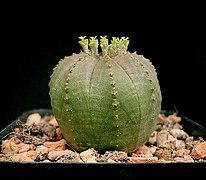Euphorbia obesa
| Euphorbia obesa | |
|---|---|

| |
| Scientific classification | |
| Kingdom: | Plantae |
| Clade: | Tracheophytes |
| Clade: | Angiosperms |
| Clade: | Eudicots |
| Clade: | Rosids |
| Order: | Malpighiales |
| Family: | Euphorbiaceae |
| Genus: | Euphorbia |
| Species: | E. obesa
|
| Binomial name | |
| Euphorbia obesa | |
Euphorbia obesa is a subtropical succulent species in the genus Euphorbia. It comes from South Africa, especially in the Cape Province. Sometimes referred to as a Baseball plant.
In the wild it is endangered because of over-collection and poaching, combined with its slow growth, and the fact that the pod contains only 2 to 3 seeds. However, it is widely cultivated in botanical gardens.
Description
Euphorbia obesa resembles a ball, thornless and decorative. It is commonly known as 'baseball plant' due to its shape. Its diameter is between 6 cm and 15 cm depending on its age. Young Euphorbia obesas are spherical, but become cylindrical with age. They contain water reservoirs for periods of drought.
It almost always shows 8 ridges adorned with small deep gibbosity regularly planted on the edges. It is green with horizontal lighter or darker stripes. In the wild, and with exposure to direct sunlight, it shows red and purple areas.
The plant is dioecious, which means that a subject has only male or female flowers. The small flowers are insignificant in apex. In fact, like all Euphorbia, flowers are called cyathia.
As in all Euphorbia species, the latex is toxic.[1]
Living in similar conditions on two different continents, Euphorbia obesa presents a form of convergence with Astrophytum asterias which is a cactus from Mexico.
Distribution
This species is indigenous to a small range in the arid Karoo region of South Africa. This is a region of summer rainfall.[2]
Cultivation
In cultivation in the UK, Euphorbia obesa has won the Royal Horticultural Society's Award of Garden Merit. [3]
-
Male flowers
-
Female flowers
-
Close-up of ridge
References
- ^ "Plants & Flowers >> Euphorbia obesa". PlantsRescue. N/A. Retrieved 23 December 2015.
- ^ "Bioegog template".
- ^ "Euphorbia obesa". RHS. Retrieved 23 June 2020.



